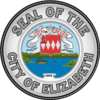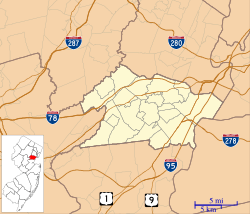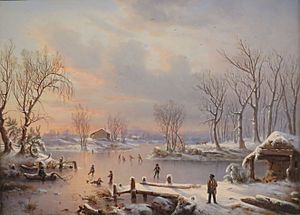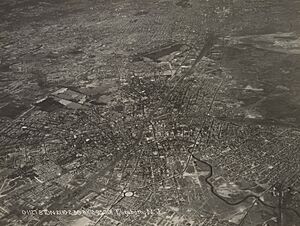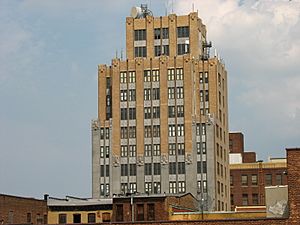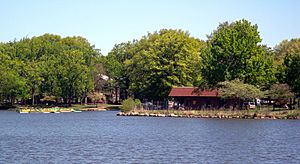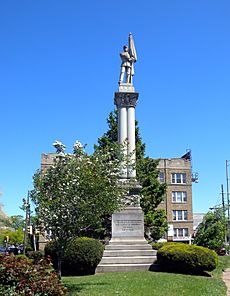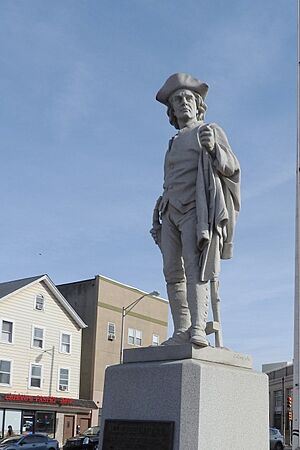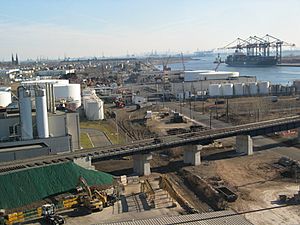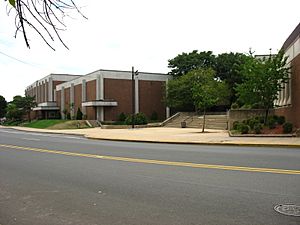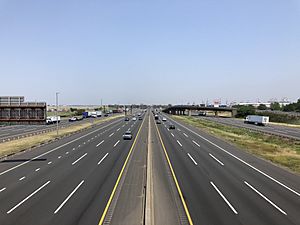Elizabeth, New Jersey facts for kids
Quick facts for kids
Elizabeth, New Jersey
|
|||
|---|---|---|---|
|
City
|
|||
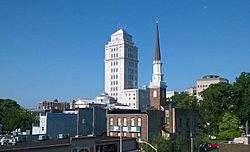
Elizabeth skyline in October 2015
|
|||
|
|||
| Motto(s):
Loyal Devoir
|
|||

Location of Elizabeth in Union County highlighted in yellow (center). Inset map: Location of Union County in New Jersey highlighted in black (upper right).
|
|||

Census Bureau map of Elizabeth, New Jersey
|
|||
| Country | |||
| State | |||
| County | Union | ||
| Founded | 1664 | ||
| Incorporated | March 13, 1855 | ||
| Named for | Elizabeth, wife of Sir George Carteret | ||
| Government | |||
| • Type | Faulkner Act (mayor–council) | ||
| • Body | City Council | ||
| Area | |||
| • Total | 13.64 sq mi (35.32 km2) | ||
| • Land | 12.32 sq mi (31.91 km2) | ||
| • Water | 1.32 sq mi (3.42 km2) 9.78% | ||
| Area rank | 180th of 565 in state 1st of 21 in county |
||
| Elevation | 16 ft (5 m) | ||
| Population
(2020)
|
|||
| • Total | 137,298 | ||
| • Estimate
(2023)
|
135,829 | ||
| • Rank | 207th in country (2023) 4th of 565 in state (2020) 5th in state (2023) 1st of 21 in county |
||
| • Density | 11,145.22/sq mi (4,303.27/km2) | ||
| • Density rank | 32nd of 565 in state 2nd of 21 in county |
||
| Time zone | UTC−05:00 (Eastern (EST)) | ||
| • Summer (DST) | UTC−04:00 (Eastern (EDT)) | ||
| ZIP Codes |
07201 – Union Square station
07202 – Bayway station 07206 – Elizabethport station 07207 – P.O. Boxes 07208 – Elmora station |
||
| Area code(s) | 908 | ||
| FIPS code | 3403921000 | ||
| GNIS feature ID | 0885205 | ||
Elizabeth is a city in New Jersey, located in Union County. It's also the main city, or county seat, of Union County. In 2020, Elizabeth was the fourth-largest city in New Jersey. It had a population of 137,298 people. This number grew by about 12,000 people since 2010.
In 2023, the city's population was estimated to be around 135,829. This makes Elizabeth one of the biggest cities in the state and the 207th most populated city in the entire United States.
Contents
- Exploring Elizabeth's Past
- Where is Elizabeth Located?
- Exploring Elizabeth's Neighborhoods
- Midtown / Uptown: The Main Hub
- Bayway: A Community by the Water
- Downtown / Elizabethport: The Oldest Area
- Elmora and The West End: Residential Charm
- Elmora Hills: A Higher View
- Frog Hollow: A Historic Spot
- Keighry Head: Close to Midtown
- North End / North Elizabeth: A Diverse Area
- Peterstown: A Village Feel
- The Point / the Crossroads: Transforming Area
- Quality Hill: Once Mansions, Now Condos
- Westminster: Green Spaces and Hills
- Elizabeth's Weather
- Population and People
- Elizabeth's Economy
- Elizabeth's Police Department
- Elizabeth's Fire Department
- Learning in Elizabeth: Schools and Libraries
- Getting Around Elizabeth: Transportation
- Local News and Media
- Famous People from Elizabeth
- Sister Cities
- See also
Exploring Elizabeth's Past
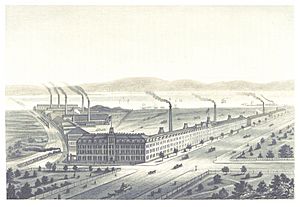
Elizabeth was first called "Elizabethtown." It was founded in 1664 by English settlers. The town was named after Elizabeth, the wife of Sir George Carteret. He was one of the first owners of the New Jersey colony. Many people think it was named after Queen Elizabeth I, but that's not true! Elizabethtown was also the very first capital of New Jersey.
During the American Revolutionary War, British forces often attacked Elizabethtown. They were based in Manhattan and Staten Island. A big battle, the Battle of Springfield, stopped the British from taking over New Jersey. After the war, in 1789, George Washington left from Elizabethtown by boat to go to Manhattan for his inauguration. You can find many memorials about the American Revolution in Elizabeth.
On March 13, 1855, Elizabethtown officially became the City of Elizabeth. This happened when the New Jersey Legislature combined two older areas, Elizabeth Borough and Elizabeth Township. A few years later, in 1857, the city became part of the new Union County.
Elizabeth became a place for big industries. The first major one was the Singer Sewing Machine Company, which employed thousands of people. In 1895, one of the first car companies, Electric Carriage and Wagon Company, started here. The Electric Boat Company also began in Elizabeth. They built submarines for the United States Navy, including the first one, USS Holland (SS-1), launched in 1897. Elizabeth grew a lot, similar to its neighbor Newark.
Where is Elizabeth Located?
Elizabeth covers about 13.66 square miles (35.37 square kilometers). Most of this area is land, with a smaller part being water.
The city shares borders with several other towns. To the southwest is Linden. To the west are Roselle and Roselle Park. To the northwest, you'll find Union and Hillside. To the north, Elizabeth borders Newark. On the east, the city is across Newark Bay from Bayonne and across the Arthur Kill from Staten Island, New York.
A small part of Shooters Island belongs to Elizabeth, even though it's managed by New York City. The Elizabeth River flows through the city for about 4.2 miles (6.8 km) before it reaches the Arthur Kill.
Exploring Elizabeth's Neighborhoods
Midtown / Uptown: The Main Hub
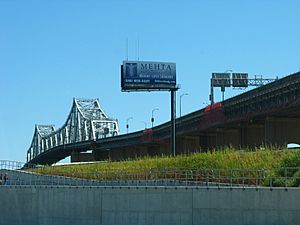
Midtown, also called Uptown, is the main business area and a historic part of Elizabeth. Here, you can find old churches like the First Presbyterian Church and St. John's Episcopal Church. The First Presbyterian Church was even a battleground during the American Revolution. Other notable buildings include the 1931 Art Deco Hersh Tower, the Thomas Jefferson Arts Academy, and the Ritz Theatre, which opened in 1926.
Bayway: A Community by the Water
Bayway is in the southern part of Elizabeth, next to Linden. This area has been home to a strong Polish community for many years. Many residents used to work at the nearby oil refinery. Bayway has unique restaurants, bars, and shops. You'll find older, well-kept houses and apartment buildings here. The western end of the Goethals Bridge, which connects to Staten Island, is also in Bayway.
Downtown / Elizabethport: The Oldest Area
Downtown, also known as E-Port or The Port, is the oldest neighborhood in Elizabeth. It has a mix of old and new houses and apartment buildings. This area was once a busy center for trade and shipping from the 1660s until the mid-1900s. Since 2000, many improvements have been made, with renovated homes and new buildings. The waterfront now has new townhomes.
The Singer Manufacturing Company, famous for sewing machines, had a huge factory here. It opened in 1873 and employed 6,000 workers, making most of the world's sewing machines at the time. The company moved out in 1982. The Elizabeth Marina, a waterfront park, has also been cleaned up and is now a place for community celebrations.
Elmora and The West End: Residential Charm
Elmora is a middle-class neighborhood in western Elizabeth. Elmora Avenue, the main street, has many restaurants, shops, and boutiques. Some tall buildings on the edge of this neighborhood offer views of the New York City skyline.
Elmora's Jewish Community
The Elmora section of Elizabeth is home to a large Modern Orthodox Jewish community. The Jewish Educational Center of Elizabeth was started in 1941 by Rabbi Pinchas Mordechai Teitz.
Elmora Hills: A Higher View
Elmora Hills is in the northwestern part of Elmora. It's a well-off neighborhood. The name "Elmora" comes from the El Mora Land Company, which developed the area. This part of the city was once part of Union Township but became part of Elizabeth in the early 1900s.
Frog Hollow: A Historic Spot
Frog Hollow is a small neighborhood east of Atlantic Street. Its name comes from the frogs that used to live in its marshy areas. This community has older, more affordable homes and some good restaurants. The statue honoring former Mayor Mack on Elizabeth Avenue is a well-known landmark here.
Keighry Head: Close to Midtown
This neighborhood is named after James Keighry, who owned a business in the area. Keighry Head is close to Midtown and offers affordable homes and apartments. It's convenient for shopping and transportation.
North End / North Elizabeth: A Diverse Area
The North End, also known as "North Elizabeth," is a diverse working-class neighborhood. It was mostly developed in the 1920s for workers at the Duesenberg automobile plant. Many Irish and Portuguese immigrants settled here. The North End has easy access to New York City and Newark through its own train station, major roads, and the New Jersey Turnpike. It's also close to Newark Liberty International Airport.
Peterstown: A Village Feel
Peterstown, or "The Burg," is a middle-class neighborhood in the southeastern part of the city. It's named after John Peters, who owned much of the land. This area was first settled by Germans and later by Italian immigrants. Peterstown has quiet streets and affordable homes, giving it a "village" feel. It's home to the historic Union Square, where you can find fresh produce, meat, and fish.
The Point / the Crossroads: Transforming Area
The Point, also called the Crossroads, is in the center of Elizabeth. It's changing with many new affordable homes and apartments being built.
Quality Hill: Once Mansions, Now Condos
This area was once known for its mansions. It's now a quiet middle-class community with many new condominiums.
Westminster: Green Spaces and Hills
Westminster is named after its large Tudor-style homes. This neighborhood borders Hillside, with the Elizabeth River creating green spaces and rolling hills. Residents enjoy this area for recreation, including Phil Rizzuto Park. It is one of the more well-off areas of Elizabeth.
Elizabeth's Weather
The climate in Elizabeth has hot, humid summers and cool to cold winters. It's a mix of a humid subtropical climate and a hot-summer humid continental climate.
Population and People
| Historical population | |||
|---|---|---|---|
| Census | Pop. | %± | |
| 1810 | 2,977 | — | |
| 1820 | 3,515 | 18.1% | |
| 1830 | 3,455 | −1.7% | |
| 1840 | 4,184 | 21.1% | |
| 1850 | 5,583 | 33.4% | |
| 1860 | 11,567 | 107.2% | |
| 1870 | 20,832 | * | 80.1% |
| 1880 | 28,229 | 35.5% | |
| 1890 | 37,764 | 33.8% | |
| 1900 | 52,130 | 38.0% | |
| 1910 | 73,409 | 40.8% | |
| 1920 | 95,783 | 30.5% | |
| 1930 | 114,589 | 19.6% | |
| 1940 | 109,912 | −4.1% | |
| 1950 | 112,817 | 2.6% | |
| 1960 | 107,698 | −4.5% | |
| 1970 | 112,654 | 4.6% | |
| 1980 | 106,201 | −5.7% | |
| 1990 | 110,002 | 3.6% | |
| 2000 | 120,568 | 9.6% | |
| 2010 | 124,969 | 3.7% | |
| 2020 | 137,298 | 9.9% | |
| 2023 (est.) | 135,829 | 8.7% | |
| Population sources: 1810–1970 1810–1920 1810 1820 1830 1840 1850–1870 1850 1870 1880–1890 1890–1910 1860–1930 1940–2000 2000 2010 2020 * = Lost territory in previous decade. |
|||
How Diverse is Elizabeth?
Elizabeth is a very diverse city. In 2019, almost half of the people living there were born in other countries. The Latino population made up about 65% of the city's total population.
The 2010 census showed that about 59.5% of the population identified as Hispanic or Latino. Elizabeth had one of the highest percentages of Hispanic residents among cities in New Jersey at that time.
Elizabeth's Economy
Since World War II, Elizabeth's transportation has grown a lot. The Port Newark-Elizabeth Marine Terminal is one of the busiest ports in the world. Newark Liberty International Airport, which is partly in Elizabeth, is also very busy.
Elizabeth is home to popular places like Little Jimmy's Italian Ices (since 1932), The Mills At Jersey Gardens outlet mall, and the Elizabeth Center. These places bring in a lot of money for the city. Elizabeth also shares the Bayway Refinery with Linden, which makes petroleum products for the New York/New Jersey area.
Parts of Elizabeth are in an Urban Enterprise Zone (UEZ). This program helps encourage businesses to create jobs and invest in the area. Shoppers in these zones can pay a lower sales tax rate.
Elizabeth's Police Department
The Elizabeth Police Department started in May 1858. The department has a Police Director and a Chief of Police. It is authorized to have 365 officers, including captains, lieutenants, and sergeants.
Elizabeth's Fire Department
| Operational area | |
|---|---|
| Country | United States |
| State | New Jersey |
| City | Elizabeth |
| Agency overview | |
| Established | January 1, 1902 |
| Staffing | Career |
| Fire chief | Sal Barraco |
| EMS level | BLS |
| Facilities and equipment | |
| Divisions | 1 |
| Battalions | 2 |
| Stations | 7 |
| Engines | 7 |
| Ladders | 3 |
| Rescues | 1 |
| Ambulances | 5 |
| Tenders | 1 |
| HAZMAT | 1 |
| USAR | 1 |
| Fireboats | 1 |
| Light and air | 1 |
The Elizabeth Fire Department helps protect the city from fires and provides emergency medical services. It started as a volunteer group in 1837 and became a paid department on January 1, 1902. The department has 7 Engine Companies, 3 Ladder Companies, 1 Rescue Company, and other special units. These teams are led by a Deputy Chief and two Battalion Chiefs.
The department is also part of the Metro USAR Strike Team. This team includes nine fire departments from North Jersey and other emergency services. They work together to handle big emergency rescue situations.
Where are the Fire Stations?
| Engine company | Ladder company | Special unit | Command unit | Address |
|---|---|---|---|---|
| Engine 1 | Air Cascade Unit | 24 South Broad Street | ||
| Engine 2 | 651 South Broad Street | |||
| Engine 3 | Ladder 2 (Tiller) | Haz-Mat Unit 1, Haz-Mat Decon Trailer | Battalion 1 | 442 Trumbull Street |
| Engine 5 | QRV 1 (Quick Attack Response Vehicle), Foam Unit, Fire Boat 1 (docked at the port) | 147 Elizabeth Avenue | ||
| Engine 6 | Tower Ladder 3 | 472 Catherine Street | ||
| Engine 7 | Ladder 1 | Rescue 1, Rescue 2 – (Metro USAR Collapse Rescue Strike Team Unit), Special Operations Vehicle 1 (USAR Support) | Car 42 (Deputy Chief), Battalion 2 | 411 Irvington Avenue |
| Engine 8 | Tactical Support Unit 1 | 524 West Grand Street |
Emergency Medical Services (EMS)
The Elizabeth Fire Department also has an EMS division. This team of civilian emergency medical technicians (EMTs) responds to about 20,000 calls each year. They operate several ambulances and supervisors throughout the day and night.
Hatzalah of Union County also provides EMS, mainly in the Elmora Hills neighborhood of Elizabeth and parts of nearby towns.
Learning in Elizabeth: Schools and Libraries
Elizabeth's public schools are run by Elizabeth Public Schools. They serve students from pre-kindergarten all the way through twelfth grade. The district is one of the "SDA Districts" in New Jersey. This means the state helps cover the costs for school building and renovation projects. A nine-member board of education oversees the district.
In the 2018–19 school year, the district had 36 schools and about 28,712 students. There were 2,173 teachers, meaning about 13 students for every teacher.
High schools in Elizabeth include:
- Elizabeth High School Frank J. Cicarell Academy
- J. Christian Bollwage Finance Academy
- John E. Dwyer Technology Academy
- Thomas A. Edison Career and Technical Academy
- Admiral William F. Halsey Jr. Health and Public Safety Academy
- Alexander Hamilton Preparatory Academy
- Thomas Jefferson Arts Academy
Elizabeth High School used to be the largest high school in New Jersey. In 2009–2010, it was split into several smaller academies.
Some Elizabeth schools have received special awards. Victor Mravlag Elementary School No. 21, William F. Halloran Alternative School #22, and Terence C. Reilly School No. 7 have all won the Blue Ribbon School Award of Excellence. This is a very high honor for American schools.
Private Schools in Elizabeth
Elizabeth also has several private schools. These include:
- St. Mary of the Assumption High School (co-ed)
- Benedictine Academy (all-girls)
- Our Lady of Guadalupe Academy (K–8)
- St. Genevieve School (K–8)
These Catholic schools are overseen by the Roman Catholic Archdiocese of Newark. Saint Patrick High School closed in 2012, but a new independent school, "The Patrick School," opened in its place.
The Benedictine Preschool is located at Saint Walburga Monastery. The Jewish Educational Center includes the Yeshiva of Elizabeth, the Rav Teitz Mesivta Academy (for boys), and Bruriah High School (for girls).
Did you know? Princeton University was first founded in Elizabeth in 1746 as the College of New Jersey!
Elizabeth's Libraries
The Elizabeth Public Library is a free public library. It has a main library, which was originally a Carnegie library, and three smaller branches. In 2016, it had 384,000 books and other items.
Getting Around Elizabeth: Transportation
Roads and Highways
Elizabeth is a central point for several major roads. These include the New Jersey Turnpike / Interstate 95 and Interstate 278. Interstate 278 crosses the Arthur Kill on the Goethals Bridge, connecting Elizabeth to Staten Island. Other important routes are U.S. Route 1/9, Route 27, Route 28, and Route 439.
Elizabeth's streets are unique because they are mostly circular, with roads spreading out from the center like spokes on a wheel. The city has about 153.78 miles (247.48 km) of roads.
There are many bridges over the Elizabeth River. The South First Street Bridge was replaced, and the South Front Street Bridge, built in 1922, is currently open to allow boats to pass.
Public Transportation
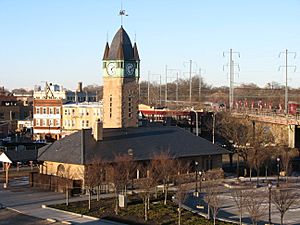
Elizabeth has a lot of train riders. NJ Transit provides train service on Amtrak's Northeast Corridor Line. There are two active train stations in Elizabeth: the Elizabeth station (also called Broad Street Elizabeth or Midtown Station) and the North Elizabeth station.
NJ Transit also offers bus service. You can take buses to and from the Port Authority Bus Terminal in Midtown Manhattan and to Newark, New Jersey. There are also local bus routes within Elizabeth.
Local News and Media
Elizabeth used to have a radio station, WJDM at 1530 AM, which broadcast from 1970 to 2019. News 12 New Jersey provides local weather and news coverage for the city. The Daily Journal newspaper was published in Elizabeth from 1779 to 1992.
Public-Access TV Channel
Residents of Elizabeth can watch a public-access television cable channel on Optimum channel 18. It shows public information, city announcements, live meetings, and health tips. It also features top TV shows, educational facts, and safety tips for the city.
Famous People from Elizabeth
Many notable people have been born in, lived in, or are connected to Elizabeth. Here are a few:
- Rick Barry (born 1944), a basketball star who played in the NBA.
- Judy Blume (born 1938), a famous author.
- Elias Boudinot (1740–1821), a leader in the Continental Congress and early U.S. Congressman.
- Todd Bowles (born 1963), a head coach in the NFL.
- Hubie Brown (born 1933), a former basketball coach and TV analyst.
- Nicholas Murray Butler (1862–1947), a winner of the Nobel Peace Prize.
- Michael Chertoff (born 1953), a former United States Secretary of Homeland Security.
- Abraham Clark (1725–1794), a signer of the Declaration of Independence.
- Tom Colicchio (born 1962), a well-known chef and TV personality.
- Jonathan Dayton (1760–1824), a signer of the United States Constitution; Dayton, Ohio, is named after him.
- Ron Freeman (born 1947), an Olympic gold medalist in track and field.
- Chris Gatling (born 1967), an NBA basketball player.
- William Halsey Jr. (1882–1959), a famous admiral in the United States Navy during World War II.
- Alexander Hamilton (c. 1755–1804), lived here as a young man.
- Kyrie Irving (born 1992), a professional basketball player in the NBA.
- Raghib Ismail (born 1969), a former NFL and CFL player.
- Marsha P. Johnson (1945–1992), an important LGBTQ activist.
- Daniel Hugh Kelly (born 1952), a stage, film, and television actor.
- William Livingston (1723–1790), a signer of the United States Constitution and the first elected Governor of New Jersey.
- Thomas Mitchell (1892–1962), an Oscar and Tony Award-winning actor.
- Don Newcombe (1926–2019), a famous baseball pitcher for the Brooklyn/Los Angeles Dodgers.
- Elizabeth Peña (1959–2014), an actress.
- Franklin Leonard Pope (1840–1885), an inventor who befriended Thomas Edison.
- Mickey Spillane (1918–2006), a writer.
- Edward Stratemeyer (1862–1930), the creator of the Hardy Boys, Bobbsey Twins, and Nancy Drew book series.
- Mickey Walker (1903–1981), a famous boxer who held Welterweight and Middleweight titles.
Sister Cities
Elizabeth has two sister cities:
See also
 In Spanish: Elizabeth (Nueva Jersey) para niños
In Spanish: Elizabeth (Nueva Jersey) para niños



